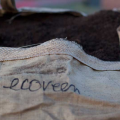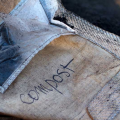Each different crop will be grown in a wooden palox box of 125×125. With 1m3 (1 cubic meter) of soil we can fill up 4 to 5 boxes with a layer between 12 and 30 cm of bio-soil, mixed with compost or ecoveen (along the needs of the plants). At dewinter groencompost, we ordered in januari 2012: 6 x 1m3 teelaarde + 2 x 1m3 edelcompost + 1 x fijne groencompost + 1 x ecoveen.
In februari 2012 we put a complementary order of: 12 x 1m3 teelaarde (from which 5m3 will be prepared in 10 bigbags
of 1/2 m3 for the trees; and 7m3 will serve for the vegetables), 3 x 1m3 fijne groencompost (for adding during the season to the crops growing), 1 x ecoveen (for keeping the water up in times of drought).



Ecoveen, edelcompost and compost. Average weight goes as follows:
° teelaarde: 800 kg/m³
° teelaarde+: 700 kg/m³
° gewone groencompost: 525 kg/m³
° edelcompost of fijne groencompost: 550 kg/m³
° ecoveen: 230 kg/m³

Gewone groencompost is door zijn iets grovere struktuur het best geschikt voor diepere grondbewerkingen en bij het aanplanten van houtachtigen.
Fijne groencompost is ideaal voor oppervlakig gebruik bij zaaien of planten en als toplaag voor gazon.
Edel compost is een mengsel van fijne groencompost aangerijkt met organische voedingsstoffen en gebruikt men best daar waar opbrengst belangrijk is.
Ecoveen is de ecologische variant voor turf met gemakkelijke waterabsorptie en een goede bewerkbaarheid.
Teelaarde plus is een mengsel van goede tuingrond met fijne groencompost.
Volledige ontleding van de samenstelling van de compostproducten, o.a. zoutgehalte, zuurgehalte, koolstof/stikstof verhouding, voedingselementen, mineralenen metalen: samenstelling groencompost.
Bemestingsadvies na grondanalyse in commercieel tuincentrum:
– tuinadvies-analyse-moestuin
– tuinadvies-analyse-siertuin
For the seedlings we use a special soil mix, enriched with vermiculite (expands, water) or peat (veen) for retaining water and enriched with perlite (volcanic, water, aeration) for a better draining of superfluous rainwater. We experiment with organic soil fertilizers: green fertilizers fixing nitrogen in the soil: phacelia, fenugreek, mustard, buckwheat: Green manure and fertilizer guide.
In terms of soil remediation (if necessary) we want to experiment with mushrooms, and we set up a mycology-lab. More info on soil improvement: hugelkultur, amrut mitti, indian soil fertilizer with cow dung.
Composting: with a little help of our friends
The self sufficient garden is not far away. With a little help from our friends, the insects and micro-organisms we can find in amounts of zillions in the garden compost heap, we can make microbial fuel cells which can power small devices (sensors) for monitoring the gardens.
Microscope registration of the micro organism activity in a rooftop compost heap. The organisms are ± 1 mm long, there are zillions of it in the compost, the surface covered here is ± 5 square mm.
The organisms are extremely active, it would be great to convert their activity into energy to power the technology to monitor the rooftop garden. Cradle to cradle.
This is how to do it: make magazine – bacteria-battery.
